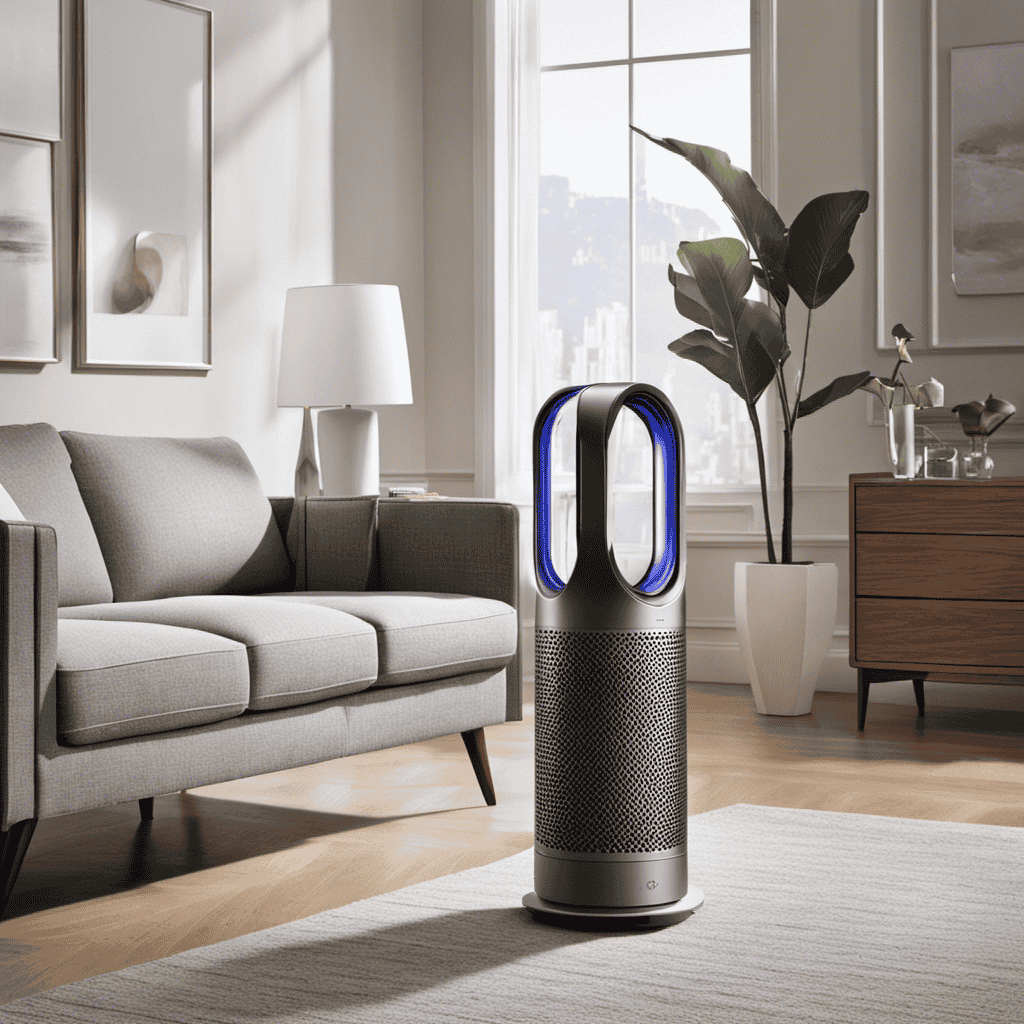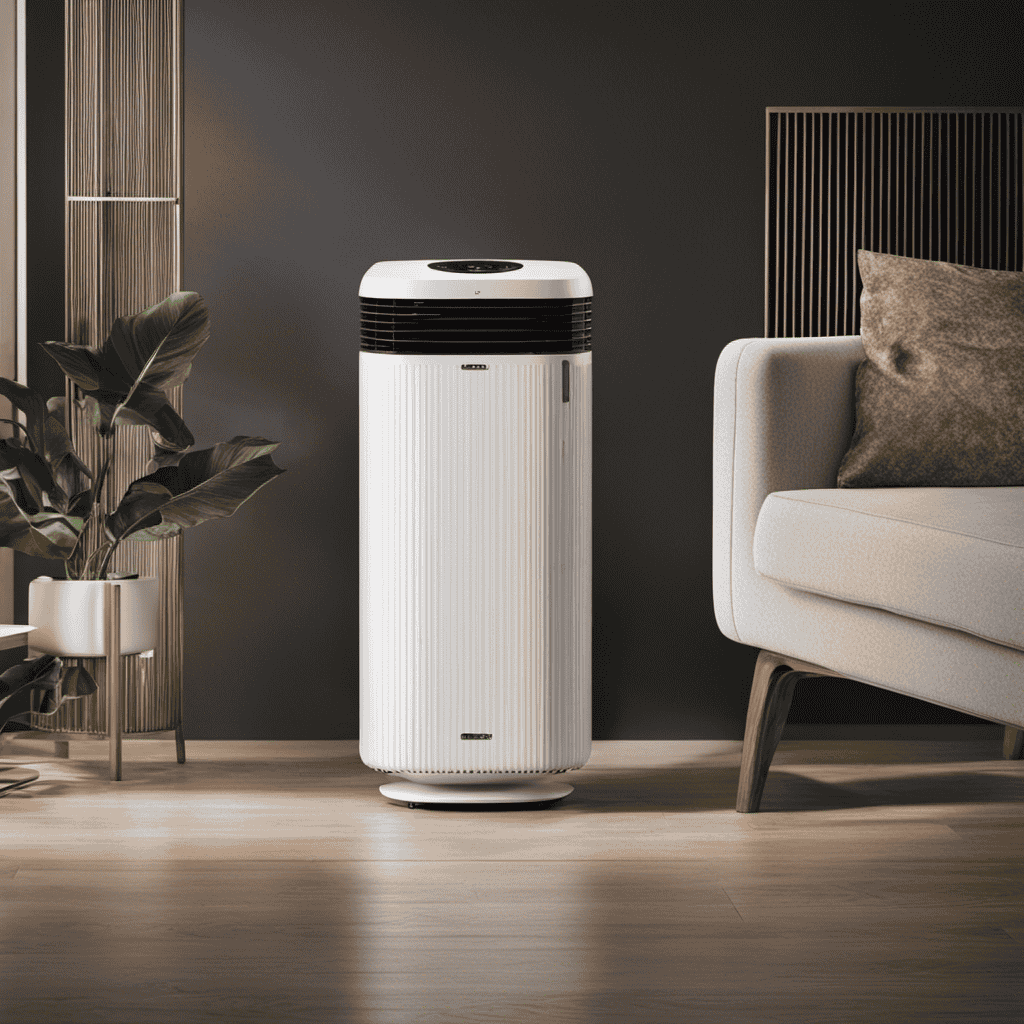As someone who is passionate about air purifiers, I have frequently thought about how often one should activate their air purifier. This is an important aspect to consider, as using it correctly can significantly improve the air quality we breathe.
In this article, we will delve into the importance of regular use, factors to consider when determining frequency, and the recommended daily usage for optimal results. So, let’s embark on this journey together and uncover the secrets of maximizing the benefits of your air purifier.
Key Takeaways
- Regular use of air purifiers ensures clean and pollutant-free air.
- Factors such as room size, air pollution level, and allergen presence should be considered when determining the frequency of air purifier usage.
- Adjusting the usage of air purifiers based on air quality helps maintain a healthier living environment.
- Balancing energy consumption and air purification is important for optimizing the effectiveness and efficiency of air purifiers.
Understanding the Importance of Regular Use
You should understand the importance of regular use of your air purifier. Consistency is key when it comes to maintaining a healthy indoor environment.
By using your air purifier regularly, you can ensure that the air you breathe is clean and free from pollutants. Air purifiers are designed to remove harmful particles such as dust, pollen, pet dander, and even smoke from the air. These particles can cause allergies, asthma attacks, and other respiratory issues.
By consistently using your air purifier, you can reduce the risk of these health problems and create a healthier living space for yourself and your loved ones.
Factors to Consider When Determining Frequency
Factors to consider when determining how frequently to switch on the air purifier include the size of the room, the level of air pollution, and the presence of allergens. The recommended maintenance for air purifiers typically includes cleaning or replacing the filters regularly. Determining usage patterns for your air purifier depends on these factors. If you have a small room with minimal air pollution and no allergens, you may only need to turn on the purifier occasionally. However, if you have a larger room with high levels of air pollution or allergens, it is recommended to keep the air purifier running continuously or for longer periods of time. Here is a table to help you understand the recommended usage patterns based on different factors:
| Room Size | Air Pollution Level | Presence of Allergens | Recommended Usage |
|---|---|---|---|
| Small | Low | None | Occasional |
| Medium | Moderate | Mild | Regular |
| Large | High | Severe | Continuous |
Recommended Daily Usage for Optimal Results
To achieve optimal results, it’s important to consider the recommended daily usage for your air purifier. Consistency is key when it comes to keeping the air in your home clean and fresh. Here are three important factors to keep in mind:
-
Balance: Finding the right balance between running your air purifier continuously and using it only when needed is crucial. Running it continuously may strain the unit and lead to unnecessary energy consumption, while using it sparingly may not effectively filter the air.
-
Room size: The size of the room where the air purifier is placed will determine how often it needs to be used. Larger rooms may require longer usage periods, while smaller rooms may benefit from shorter bursts.
-
Environmental factors: Consider the air quality in your area and any specific allergens or pollutants that may be present. If you live in a highly polluted area or have allergies, you may need to use your air purifier more frequently.
Adjusting Usage Based on Air Quality
Consider adjusting your air purifier’s usage based on the current air quality in your home. With advancements in technology, many air purifiers now come with built-in air quality monitoring, allowing you to gauge the pollution levels in real-time. This feature is especially useful for those who suffer from allergies, respiratory issues, or live in areas with poor air quality.
By integrating your air purifier into your smart home system, you can receive notifications or set automatic adjustments based on the air quality readings. This ensures that your air purifier is running efficiently when needed the most. Monitoring and adjusting your air purifier’s usage in response to the air quality in your home can help you maintain a healthier and cleaner living environment.
Now, let’s explore the benefits of continuous operation.
Benefits of Continuous Operation
One great benefit of keeping your air purifier running continuously is that it helps maintain a consistently clean and fresh environment in your home.
Here are three reasons why continuous operation is beneficial:
-
Improved Air Quality: When your air purifier runs continuously, it can effectively remove pollutants such as dust, pet dander, and allergens from the air. This helps to create a healthier living space, especially for those with allergies or respiratory issues.
-
Odor Control: Continuous operation of an air purifier can help eliminate unpleasant odors in your home, such as cooking smells, pet odors, or stale air. By constantly circulating and filtering the air, it ensures a more pleasant and fresh-smelling environment.
-
All-Day Protection: Prolonged usage of an air purifier provides round-the-clock protection against airborne contaminants. It ensures that your home remains clean and healthy, even when you’re not actively cleaning or ventilating the space.
Balancing Energy Consumption With Air Purification
When it comes to using an air purifier, it’s important to find the optimal usage frequency that balances energy consumption with air purification. By understanding how often to run your air purifier, you can save energy while still maintaining clean air.
In addition, implementing energy-saving techniques and considering air quality factors can further enhance the effectiveness and efficiency of your air purifier.
Optimal Usage Frequency
The optimal frequency for using an air purifier is typically based on factors like the air quality in your area and the specific needs of your household. To determine how often you should turn on your air purifier, consider the following factors:
-
Air Quality: If you live in an area with high pollution levels or have allergies, you may need to use your air purifier more frequently. Monitor the air quality index in your area to get a better idea of when to use it.
-
Household Needs: Consider the specific needs of your household. If you have pets or smokers at home, you may need to run the air purifier more often to remove pet dander or eliminate odors.
-
Personalized Schedule: Create a personalized schedule based on the factors above. For example, you could turn on the air purifier during peak pollution hours or when you’re most likely to be exposed to allergens.
By considering these factors, you can create a personalized schedule that ensures your air purifier is used optimally.
Now, let’s explore some energy-saving techniques to help you maximize efficiency.
Energy-Saving Techniques
Now that we have discussed the optimal usage frequency of an air purifier, it is important to consider energy-saving techniques in order to maximize the lifespan of the device.
One way to achieve this is by utilizing energy efficient settings on your purifier. Many modern air purifiers come with different fan speed options, allowing you to choose a lower setting to conserve energy while still maintaining clean air in your space. Additionally, some models have built-in timers that can be programmed to automatically turn the purifier on and off at specific times, reducing unnecessary energy consumption.
By implementing these energy-saving techniques, you can not only save on electricity costs but also extend the longevity of your air purifier.
Transitioning into the subsequent section about air quality considerations, it is vital to understand how different factors can impact the effectiveness of an air purifier.
Air Quality Considerations
Consider adjusting the placement of your device to ensure optimal air circulation throughout the room. This is important because proper air circulation helps in reducing the concentration of indoor air pollutants and minimizing the effects of air pollution on your health. Here are three things to keep in mind when considering air quality in your space:
-
Ventilation: Ensure that your room has proper ventilation by opening windows or using exhaust fans. This helps in removing stale air and bringing in fresh outdoor air, reducing the concentration of indoor pollutants.
-
Source Control: Identify and minimize potential sources of indoor air pollutants such as cigarette smoke, cleaning products, and volatile organic compounds (VOCs) from paints or furniture. This can significantly improve the air quality in your space.
-
Air Purification: Consider using an air purifier to further enhance the air quality. Air purifiers help in trapping and removing particles and allergens from the air, reducing the impact of air pollution on your health.
By taking these air quality considerations into account, you can create a healthier indoor environment.
Now, let’s move on to creating a personalized schedule for turning on your air purifier.
Creating a Personalized Schedule
When it comes to creating a personalized schedule for optimal air purifier usage, there are a few key factors to consider.
First, it is important to determine the optimal usage frequency based on the size of the room, the level of pollution, and the individual’s specific needs.
Factors such as allergies, respiratory conditions, and the presence of pets or smokers in the household should also be taken into account.
Optimal Usage Frequency
To ensure the best air quality, you should determine the optimal usage frequency for your air purifier. Consistency is key when it comes to maintaining clean and fresh air in your home. Here are three factors to consider when determining the optimal duration for using your air purifier:
-
Room size: The size of the room plays a crucial role in determining how often you should run your air purifier. Larger rooms may require longer running times to effectively filter the air, while smaller rooms may need less frequent usage.
-
Indoor pollutants: Take into account the level of indoor pollutants in your home. If you live in an area with high pollution or have pets or smokers in your household, you may need to run your air purifier more frequently to combat these impurities.
-
Allergies or respiratory conditions: If you or your family members suffer from allergies or have respiratory conditions, consistent usage of the air purifier is crucial. Running it on a regular basis can help reduce allergens, dust, and other airborne particles that can trigger symptoms.
Factors to Consider
Determining the optimal duration for using your air purifier involves taking into account factors such as room size, indoor pollutants, and allergies or respiratory conditions.
Understanding the benefits of an air purifier is essential in determining its effectiveness. Firstly, consider the size of the room where the air purifier will be used. A larger room may require longer usage periods to ensure proper air circulation and purification.
Secondly, identify the indoor pollutants present in your home, such as dust, pet dander, or pollen. If you have high levels of these pollutants, it may be necessary to run the air purifier for longer periods or even continuously.
Lastly, allergies or respiratory conditions can also impact the optimal usage duration. Individuals with allergies or asthma may benefit from running the air purifier consistently to reduce their symptoms.
Adjusting for Individual Needs
When it comes to air purifiers, it’s important to consider individual preferences and health conditions. Each person has different needs and requirements for clean air in their living space.
Here are three factors to consider when adjusting your air purifier for individual needs:
-
Allergies and Asthma: If you suffer from allergies or asthma, you may need to run your air purifier more frequently to reduce the presence of allergens and irritants in the air.
-
Room Size: The size of the room also plays a role in determining how often you should run your air purifier. Larger rooms may require more frequent use to achieve the desired level of air cleanliness.
-
Environmental Factors: Consider the surrounding environment. If you live in an area with high pollution levels or have pets, you might need to run your air purifier more often to maintain good air quality.
Should I Turn on My Air Purifier More Frequently if I Need to Change the Filter Often?
If you find yourself needing to change the filter in your air purifier frequently, you may want to consider running it more often. The frequency of changing a filter depends on a variety of factors, including the environment and the type of filter used, so consider how often to change filter based on your specific needs.
Frequently Asked Questions
Can Using an Air Purifier Too Often Have Any Negative Effects on Air Quality or Health?
Using an air purifier too often can have negative effects on respiratory health. While they can eliminate many indoor air pollutants effectively, they may not be able to remove all types completely.
Are There Any Specific Times or Situations When It Is Recommended to Turn off the Air Purifier?
There are specific times when it’s recommended to turn off the air purifier, such as when you leave the house. However, the benefits of using an air purifier far outweigh the occasional need to turn it off.
How Long Does It Typically Take for an Air Purifier to Effectively Clean the Air in a Room?
It typically takes an air purifier a few hours to effectively clean the air in a room. Factors that can affect its effectiveness include the size of the room, the quality of the air, and the strength of the purifier.
Can Using an Air Purifier Too Frequently Increase Energy Consumption Significantly?
Using an air purifier too frequently can significantly increase energy consumption. Did you know that air purifiers consume more energy compared to other household appliances? This can have a noticeable impact on your electricity bills.
Is It Necessary to Use an Air Purifier in Every Room of the House, or Is One Unit Sufficient for the Entire Living Space?
One unit may be sufficient for the entire living space, reducing costs and maintenance. However, using multiple units in each room can provide better air purification. Consider the impact on sleep quality when deciding on the number of units.
Conclusion
In conclusion, it’s crucial to establish a regular schedule for turning on your air purifier. This helps maintain a clean and healthy indoor environment. You can customize a usage plan that suits your needs by considering factors such as air quality, energy consumption, and personal preferences. Remember, consistency is key when it comes to reaping the benefits of air purification.
So, don’t forget to turn on your purifier regularly and breathe in the freshness and purity it provides. Your lungs will thank you!










